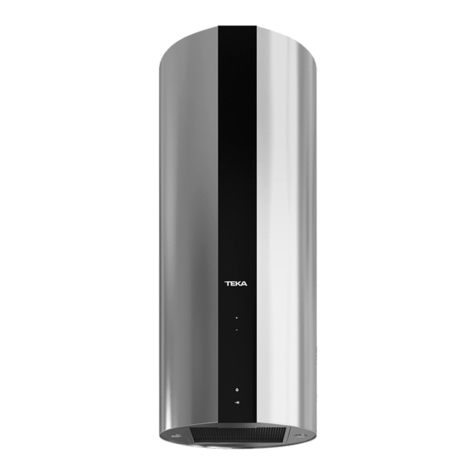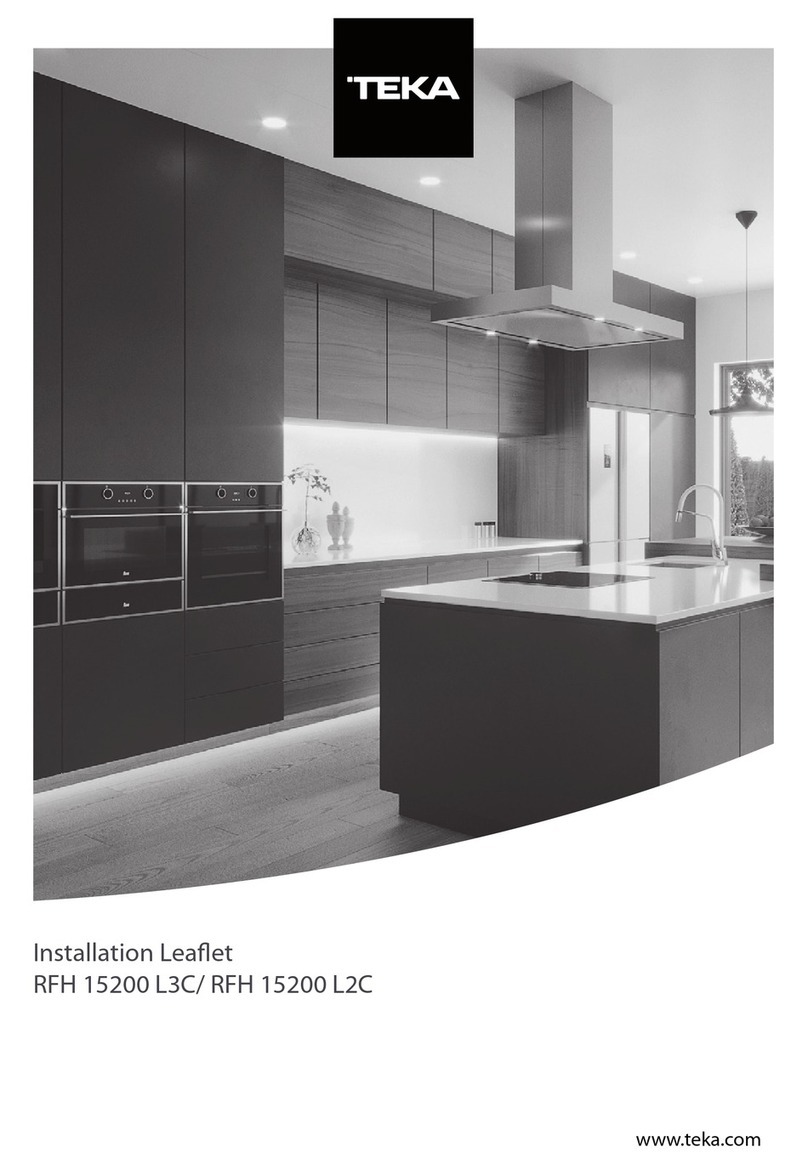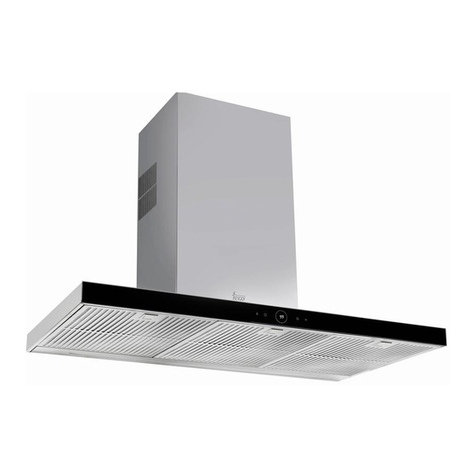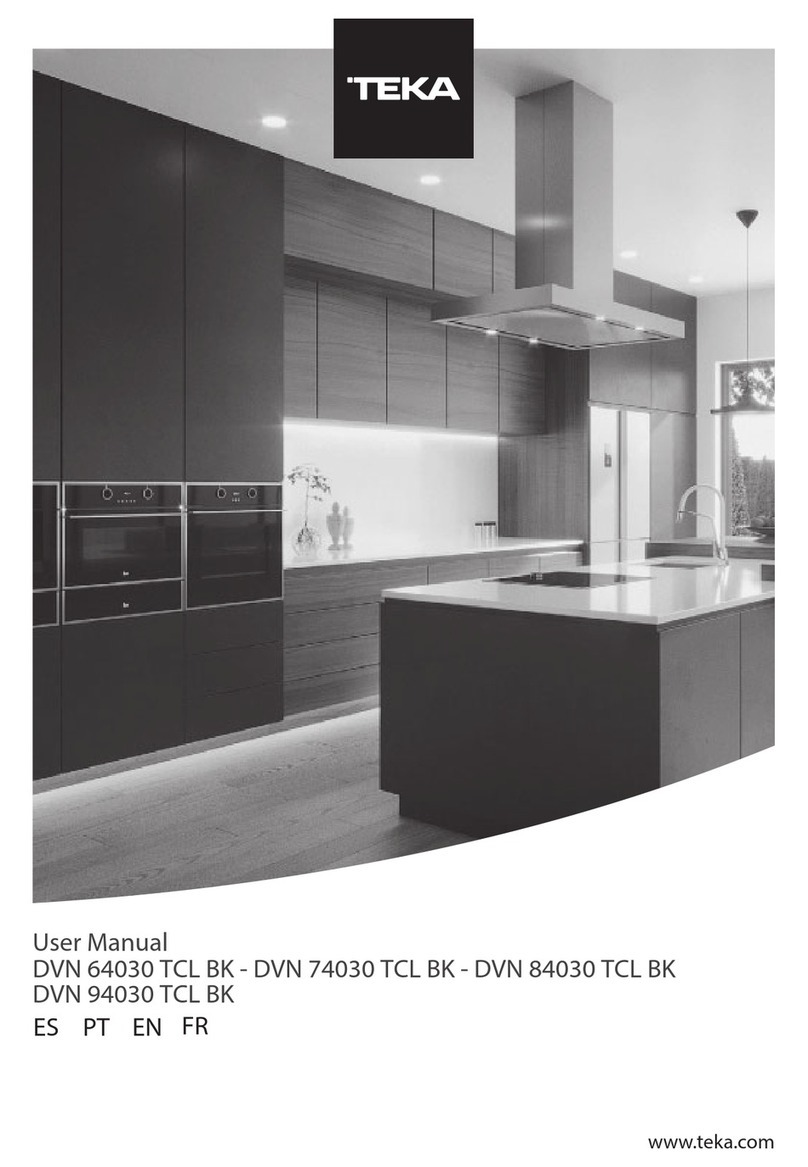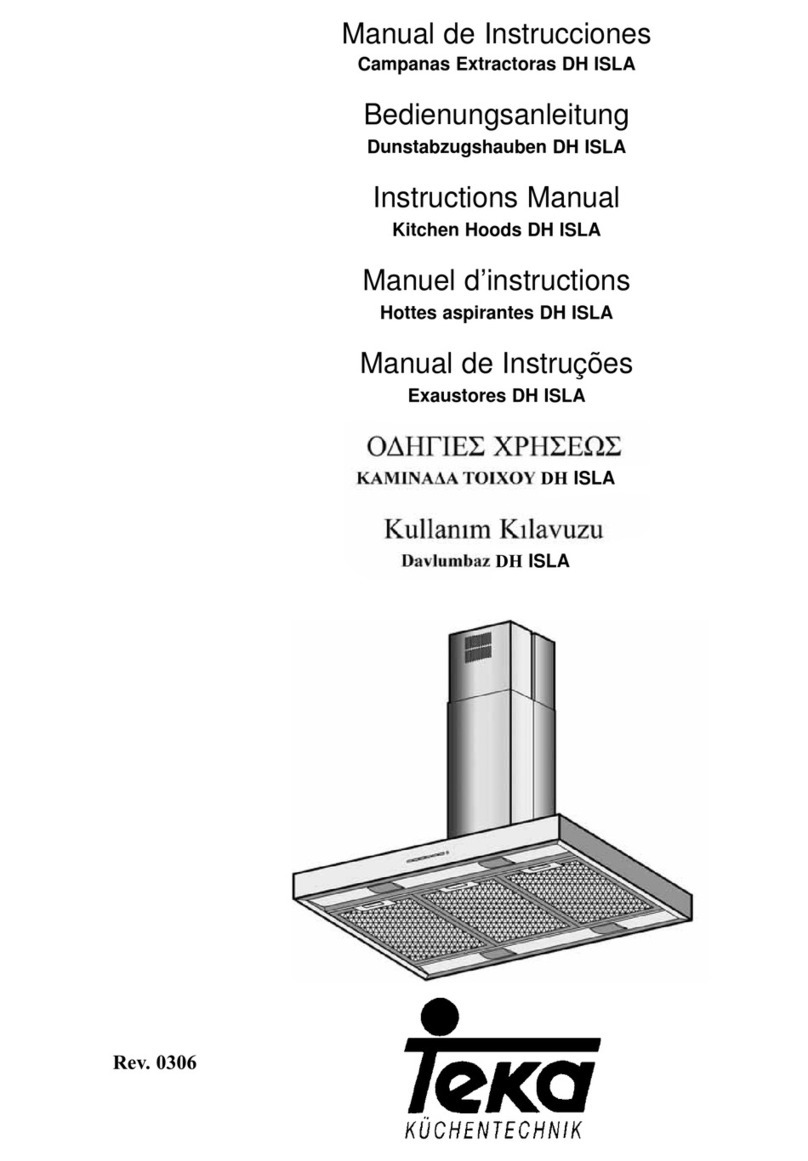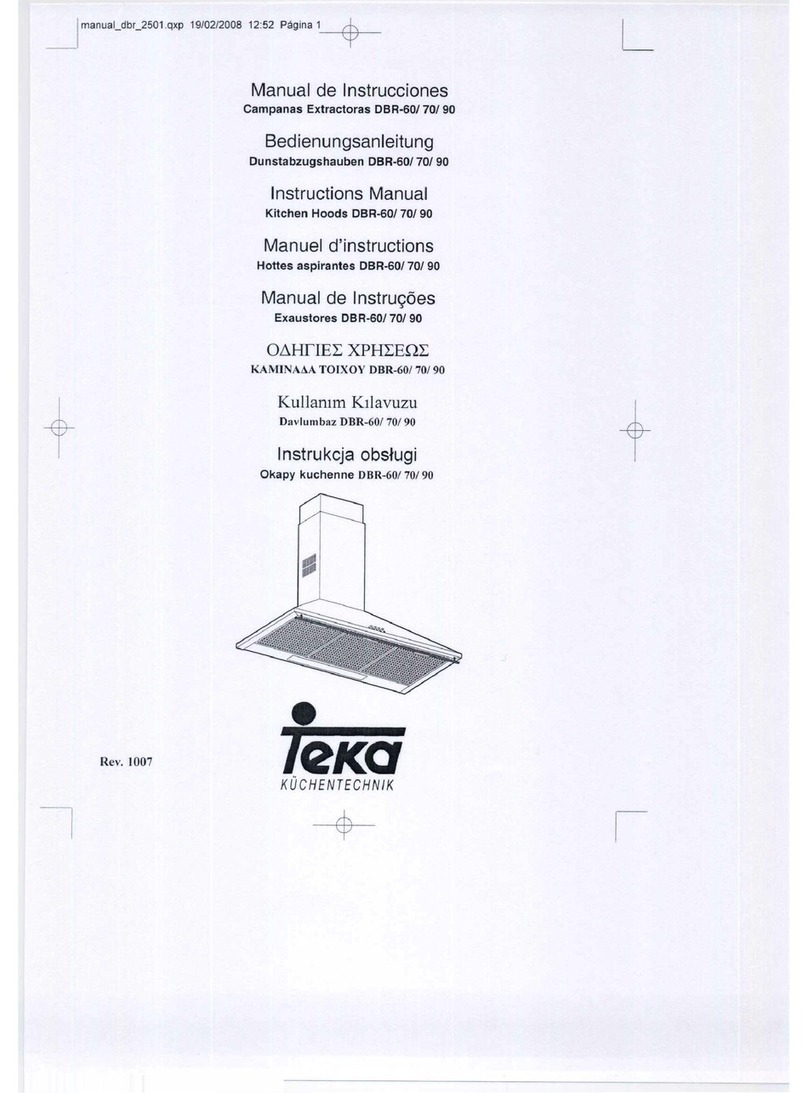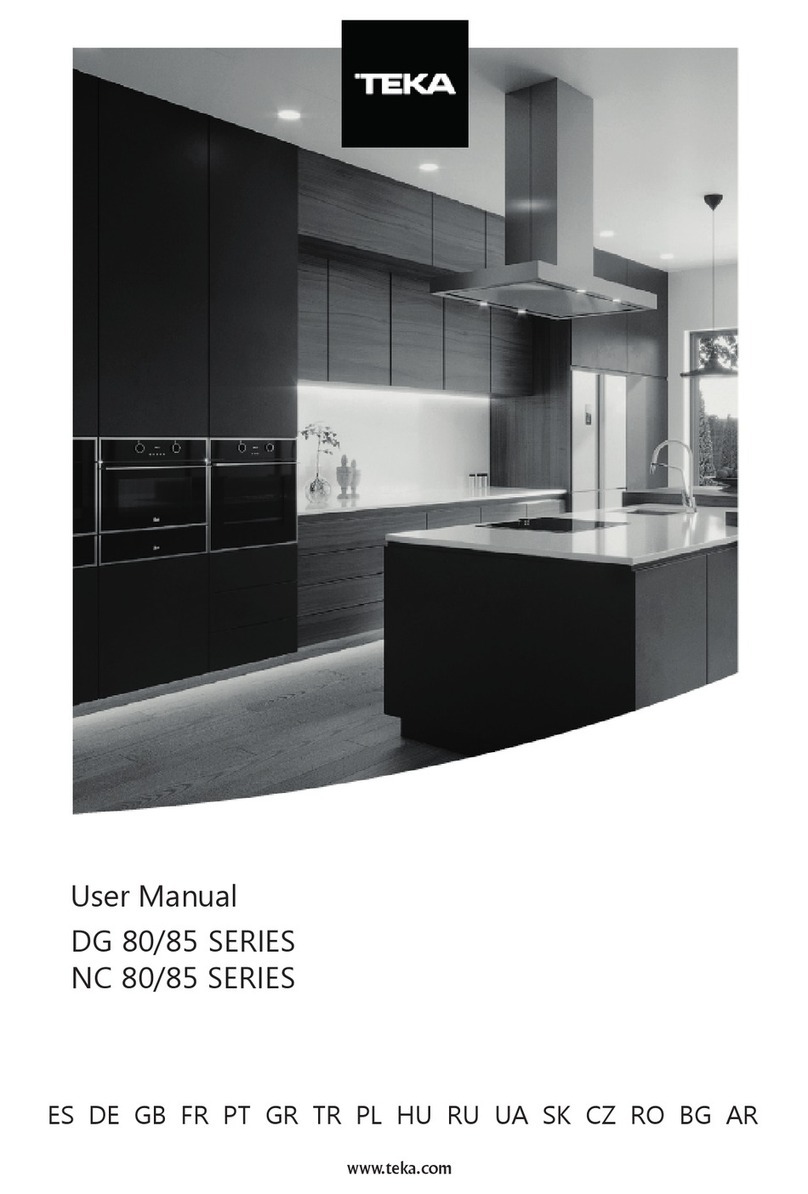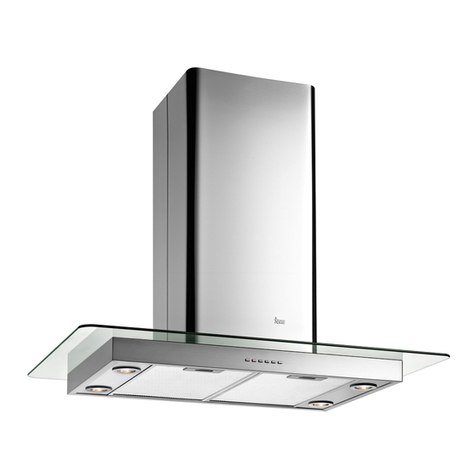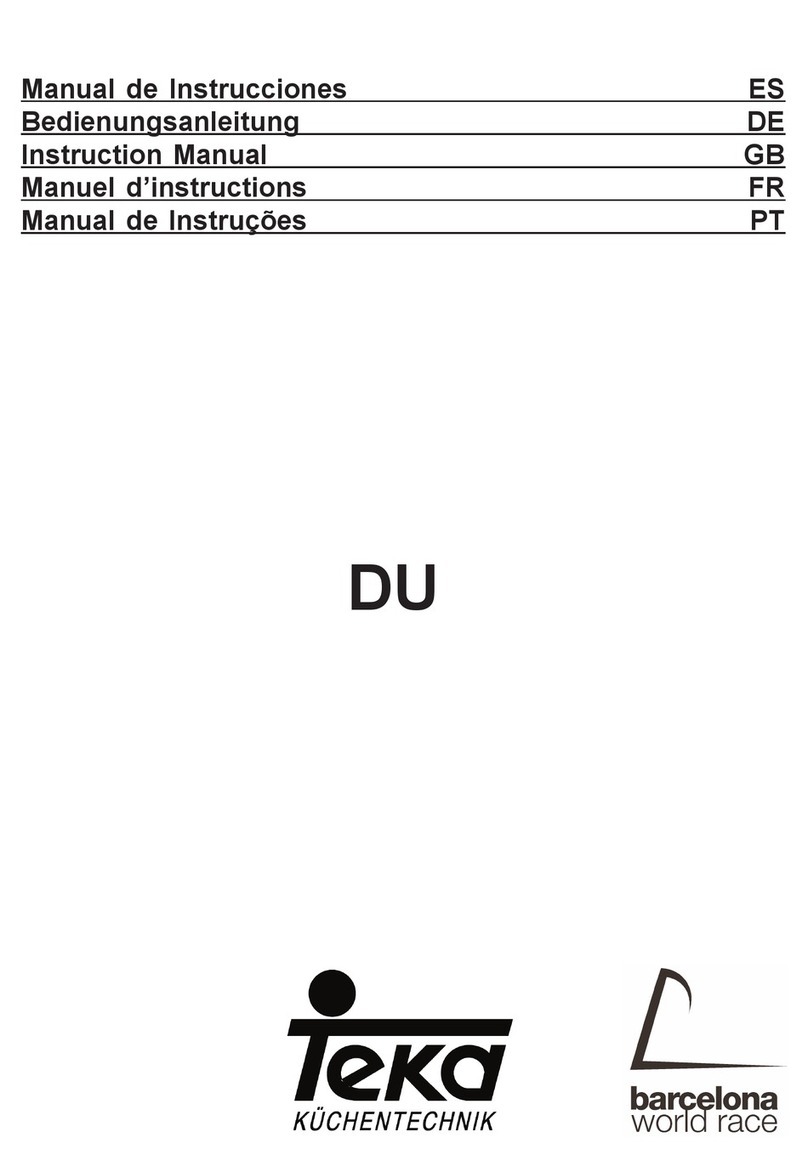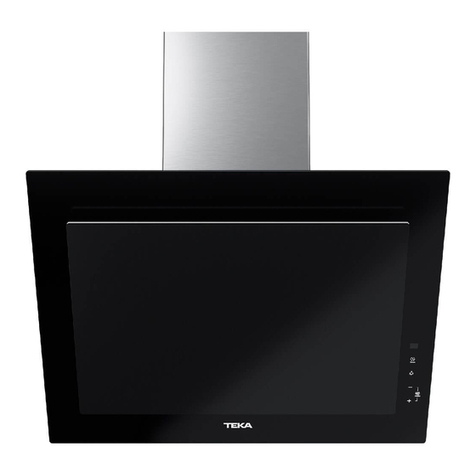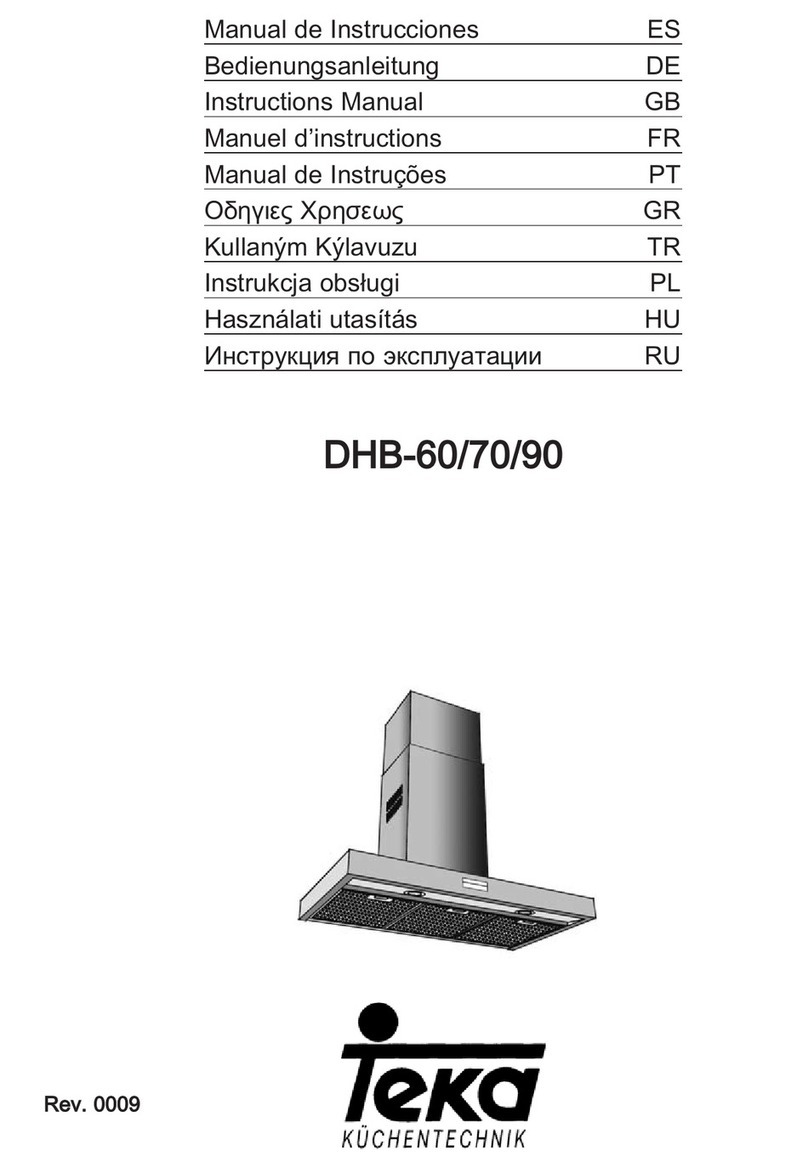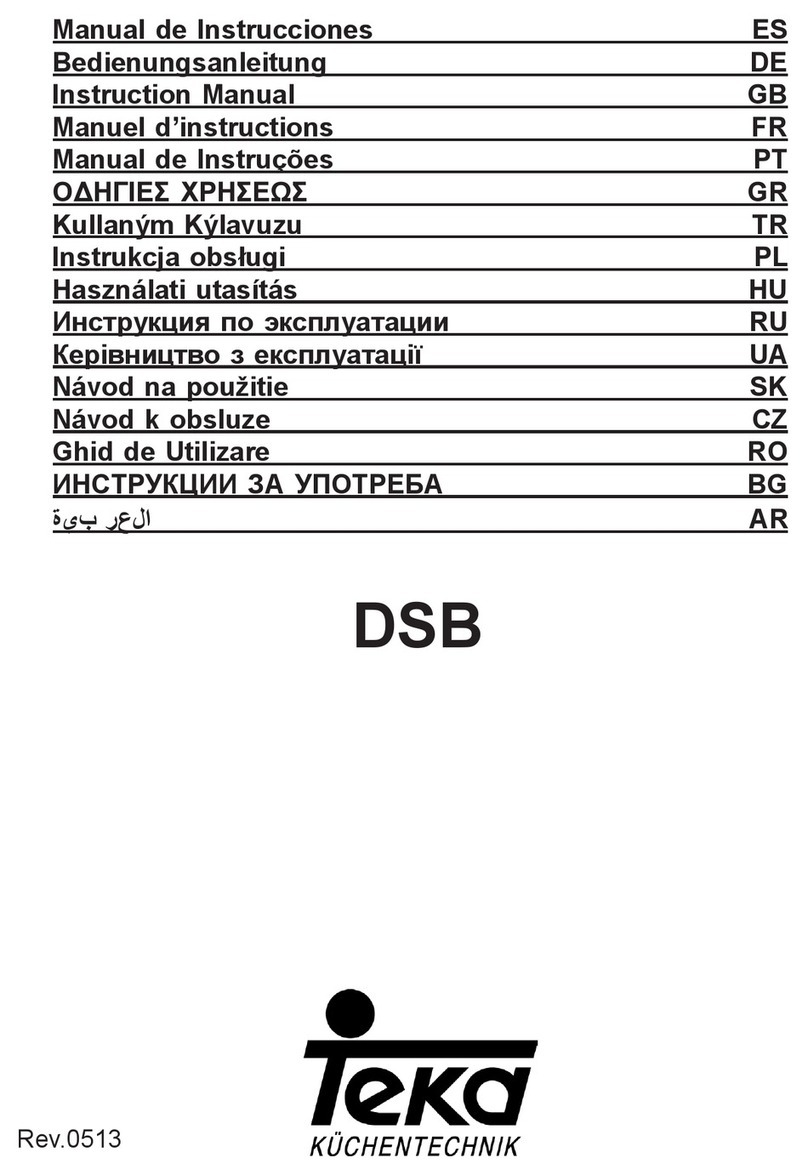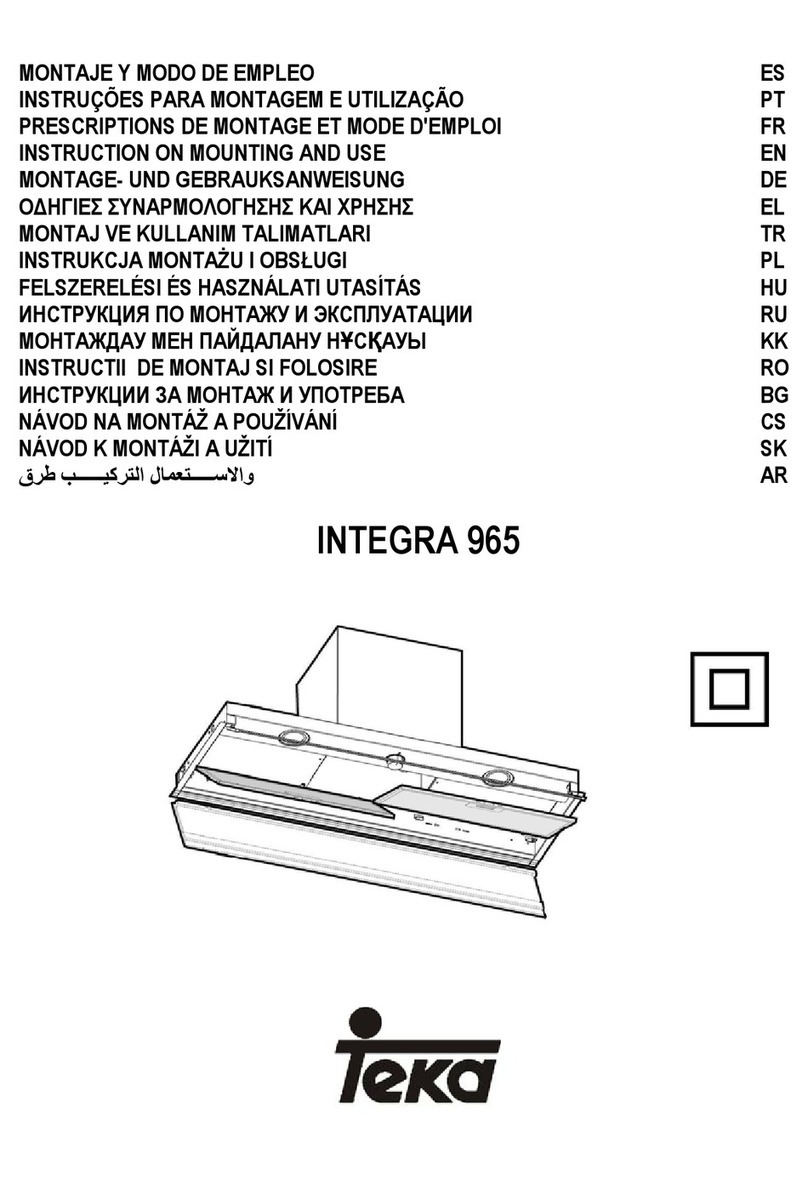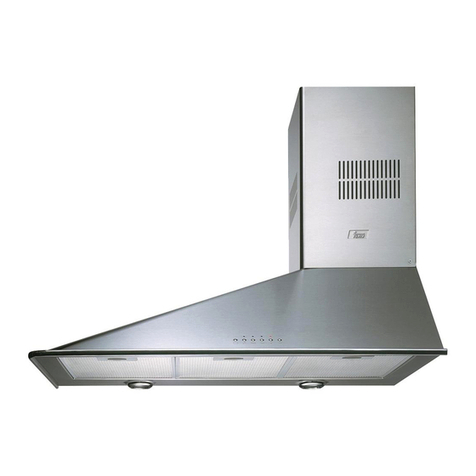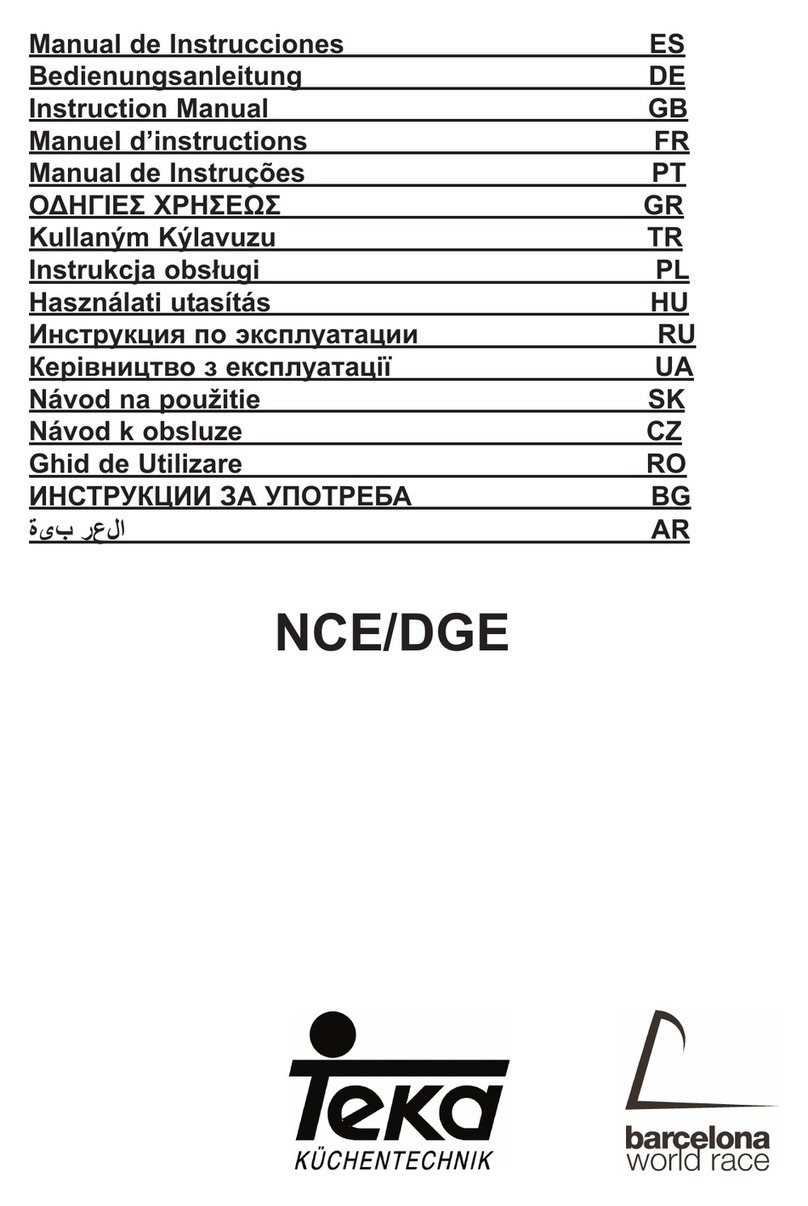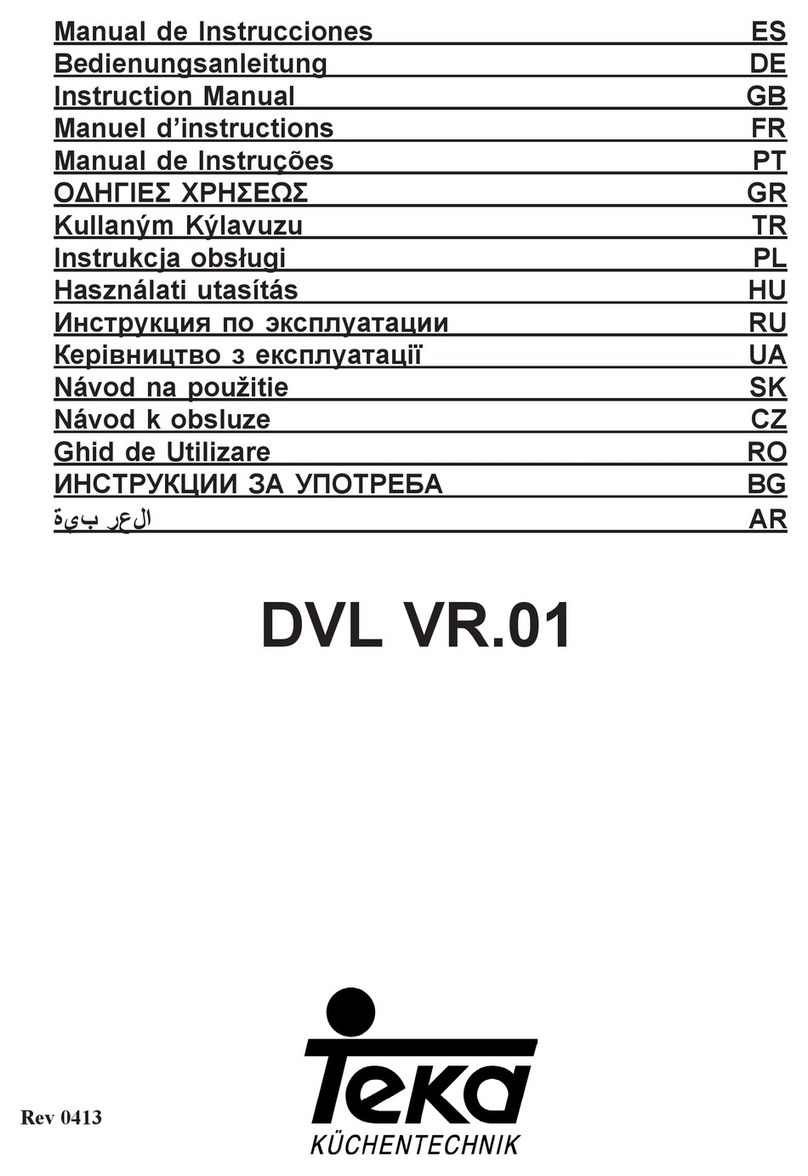GB
Introduction
PLEASEREADALLINSTRUCTIONSCAREFULLYBEFORECOMMENC-
ING INSTALLATION. CHECK THAT THE ELECTRICAL SUPPLY DATA
QUOTED ON THE RATING PLATE OF THE APPLIANCE AGREES WITH
THAT OF YOUR SUPPLY. (SEE NOTE “SAFETY REQUIREMENTS”)
Theseinstructionsare designedto tell youof the varioustechnical details
of your cooker hood and to make you familiar with its use. Since these
instructions cover more than one type of the hood within the same series,
itmaybethatreferenceismadetocomponentsthatdonotformpartofthe
hoodthat youare installing.The hoodmay beused asan exhaustor filter
hood. If evacuation is available (exhaust duct or air flue) we recommend
using the hood in the exhaust version to discharge all the kitchen vapors
andodors outdoors.
Suggestionsfor usingthe hoodin exhaustposition
Whenan exhausthood anda heatsource requiringambient air(e.g. gas,
oil,coalstoves,etc.)areusedatthesametime,attentionisrequiredbecause
the air necessary for combustion is exhausted from the room through the
hood and this creates depression. There is no such danger when the
maximumdepressionintheroomis0,04mbar.Inthisconditionnoexhaust
gasfromtheheatsourceispiped.Toassurethiscondition,makeopenings
intheroomwhichcannotbeclosed(doors,windows,etc.arenotsufficient)
and through which the air necessary for combustion can freely flow.
Note:Alltheexhaustductworkintheapartmentorhouseshouldbestudied.
In case of doubts, get advise or authorization from the person or agency
responsible for the building. When using gas burners, gas ovens, etc. as
wellaswhen usingthehoodinthefilterversion,theseprecautions arenot
necessary.
Note: The efficiency of the exhaust hood decreases as the length of the
ducts and number of elbows increase. When using the exhaust version,
followtheserules:Donotconnecttheexhausthoodtochimney,flues,and
airducts servingtheroom. Beforeventinginto exhaustfluesand ductsno
longerin use,askfor theapprovalof thepersonoragencyresponsible for
thebuilding.Theevacuatedairmustnotbeletintoawarmairduct.Forthe
evacuation of the exhausted air please note ufficial instructions.
Installation
The hood must be mounted over the centre of the cooking area. The
minimumdistancesbetweenthecookingareaandtheunderpartofthehood
are 650 mm.
Warning:Iftheroomcontainsafluedfuelburningappliancewhichisnotof
the“balanceflue”typemakesuretheseisanadequateairinlettotheroom
at all times so that fumes are not drawn down the flue.
N.B.Thedistances,however,aresubjecttothesafetyrulesineffectinthe
variouscountries.Beforedrillingthewall makesurethatnopipesorcables
willbedamaged.Ifthereisnoouterwaste-pipefortheexhaustversion,an
airoutletwith adiameterofØ160mm,incaseyouusethe spigotreduction
(pict.5/C) you need an exhaust outlet of 130mm.
Attention:Takeattentionthatthewallwillsupporttheweightofthecookerhood
(about 30 Kg). The screws supplied with this rangehood are designed for
fixing to reinforced concrete, masonry walls or hollow building blocks.
Installationwithoutbracket
1) Set the distance between the cooker hob and the hood (pict. 4).
2) Fix the two screws and the two upper plugs into the wall at the height
previously chosen (pict. 5).
3) Hang the hood to the wall checking that the screw (pict. 5/P) correctly
fits into the hole (pict. 5/R).
4) Inorder toprovide anexact installationthe cookerhood (inthe rearof
the body) is supplied with two holes of 8 mm diameter, where the two
screwswithplugshavetobeinserted.Insurethatallpartsareproperly
fixed and that it is impossible to touch moving parts.
Connectionfiltering/exhaust
1) Intheexhaustversionlinka125mmdiameterairoutletchimneytothe
spigot (pict. 5/M). This pipe is not supplied with the hood.
2) Ifthefiltering connection(pict.5/N)is madeofsteelfix itontothehood
outlet by means of the three screws supplied.
Installation of the pipes (valid for exhaust or filter version)
1) Fix the bracket (pict. 5/D) with 2 plugs and screws (pict. 5/E) in the
requiredhigh forthe pipe.
2) Screw the short pipe (pict. 5/F) with 2 screws on the bracket (pict. 5/
G).
3) Putthelongpipeovertheshortone(pict.5/I)bypullingapartthelaterals
ofthepipe.
4) Fix the long chimney from the outside (pict. 5/L) by using two screws
whichmust beinsertedinto theholesatthefoot ofthechimney (pict.5/H).
Electric connection
Makesure thesupply voltageratings correspondwith thosestated onthe
appliancedataplate.
Attention: if the appliance is not provided with a plug or cannot be easily
connected to a wall socket, then the electrical circuit must incorporate a
circuit breaker having at least a 3 mm separation between contacts. If the
applianceis providedwitha supplycordand plug,theappliances mustbe
positioned so that the plug is accessible.
Attention: the electrical supply cable must be connected as follow:
Green/Yellow=ground —Blue=neutral —
Brown = line
Important: the hood manufacturer will not be responsible for any damage
or loss caused by failure to observe these instructions.
Important:adamagedpowersupplycordmustbereplacedbytheservice.
Operating instructions
The cooker hood should be switched on either before or at the same as
cooking or frying commences. The grease and carbon filters are more
effective if the fan is not switched off immediately after cooking or frying is
completed,butonlyafteraperiodofsome20-30minutes.Beforeusingthe
cookerhoodpleaseensurethatallplasticfilmslikeonmetalgreasefilteran
stainless steel ducting are removed.
User instructions
Working instruction of the cooker hood
Mechanical Switches (Pict.3) (slide or pushbutton)
1 - Speed Switch 2 - Light Switch
LampReplacement
To changes a incandescent bulbs please work from outside of the hood
meansto pulloff thelamp diffuser.Never uselamps witha wattagehigher
thantheoneshownonthelabelinsidethehood.
Safety rules
Do not do any flambé cooking underneath the hood. When frying, never
leave the pan alone because the cooking oil could flare up. Clean all the
surfacesfrequentlytoavoiddangeroffire.Thiscanbedonewithaclothor/
andwithabrushdrenchedwithdenaturedalcoholorwithanyothersimilar.
It is also important to remove and clean or substitute frequently the filter
installedinthehood.Thisapplianceisnotintendedforusebysmallchildren
orinfirmpersonswithoutsupervision.Youngchildrenshouldbesupervised
toensurethat they donot play withthe appliance.
Maintenance
NOTE:Prior toany maintenance,switch offand disconnectfrom electrical
supply.
1) Under normal cooking conditions the grease filter should be cleaned
every 10-15 days in hot water, to which a suitable detergent has been
added.Forreasonsofefficiencyandsafetyregularcleaningisadvised.
Thegreasefiltermaybesubjecttoa smallamountofshrinkageinitially.
2) The outer casing of the Cooker Hood should be cleaned with a damp
cloth.
3) Theeffectivelifeofthecarbonfilterwillnaturallydependonthefrequency
and type of cooking fumes to which it is subject. As general guide we
suggest that a replacement is fitted at least every 12 months.
4) Once a year, (more frequently with heavy usage), call a serviceman to
cleanthefanandairductstopreventbuild-upofflammablefatdeposits.
The carbon filter
Whenacarbonfilterisfitted,theairthatissuckedinisadditionallycleaned
by the active carbon particles within the filter.
Thisfiltercannotbecleanedandsoneedstobereplacedfromtimetotime,
approximatelyeverysixmonths,dependingonhowfrequentlythehoodis
inuse.
Replacing the active carbon filter (only for recirculation hoods)
Thefiltercanbeeasilyremoveditissufficienttorotateitanticlockwise(pict.
2).
Grease filter
Thisabsorbsvapour-suspendedgreaseparticlesandprotectsthekitchen
and furniture from greasy residues. The filter should be washed every 10
to15days (innormal operating conditions).Dip thefilterinto ade-greaser
solutionorputitinthedishwasher.Makesurenottodamagethefilter,which
is made of several layers of thin alloy, by hitting or crushing it.
Thealuminiumfilterwillmaychangecolour,thatwillhavenoinfluenceofthe
efficiency of the filter, may it will improve it.
Replacing or cleaning the filters
Toremovethealuminiumgrease filter(pict.1),grab theopeningtongue at
thefilter, pullitin yourdirectionand movethefilterdownwards.To reinstall
it operate reversed.
SafetyRequirements
Exhaust air must not be discharged into any chimney, or flue which may
carry combustion products from other sources. In addition, exhaust air
must not be discharged into a wall cavity unless designed for the pur-
pose. Note instructions for cleaning fan as note “4” on “MAINTE-
NANCE”. Moreover it is important to clean regularly each filter of the
hood or replace it. N.B. THE RANGEHOOD IS DESIGNED FOR IN-
DOOR USE ONLY. UNDER NO CIRCUMSTANCES SHOULD THIS
UNIT BE INSTALLED IN OUTDOOR CONDITION OR OVER A BAR-
BECUE.
